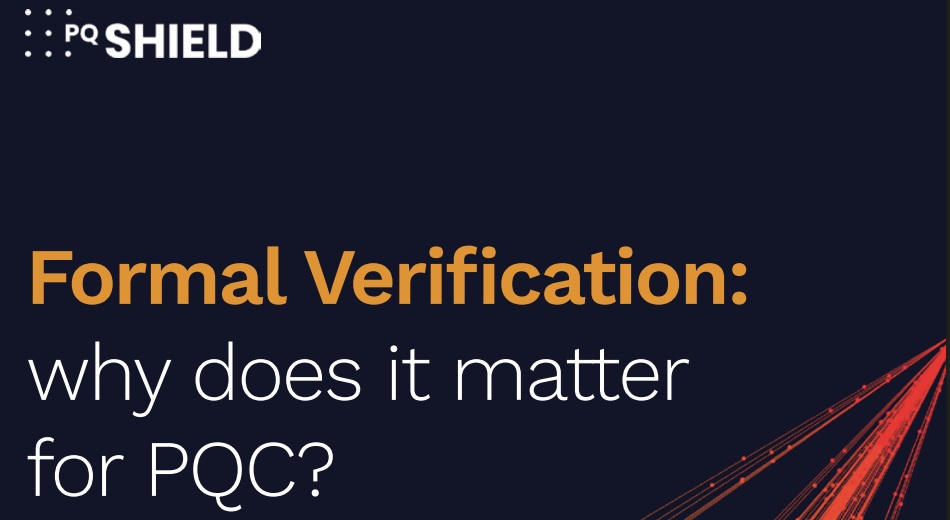Key Takeaways
- Formal verification is crucial for cryptographic systems, especially for post-quantum cryptography, as it guarantees correctness under all possible conditions using mathematical proofs.
- It operates on three dimensions: verifying the security of cryptographic specifications, ensuring implementation alignment with those specifications, and confirming resistance to low-level physical attacks.
- Companies like PQShield are leading the adoption of formal verification in cryptographic development, demonstrating its growing importance in ensuring security as systems become more complex.

Formal verification is becoming essential in the design and implementation of cryptographic systems, particularly as the industry prepares for post-quantum cryptography (PQC). While traditional testing techniques validate correctness over a finite set of scenarios, formal verification uses mathematical proofs to guarantee that cryptographic primitives behave correctly under all possible conditions. This distinction is vital because flaws in cryptographic implementations can lead to catastrophic breaches of confidentiality, integrity, or authenticity.
In cryptographic contexts, formal verification is applied across three primary dimensions: verifying the security of the cryptographic specification, ensuring the implementation aligns precisely with that specification, and confirming resistance to low-level attacks such as side-channel or fault attacks.
The first dimension involves ensuring that the design of a cryptographic primitive fulfills formal security goals. This step requires proving that the algorithm resists a defined set of adversarial behaviors based on established cryptographic hardness assumptions. The second focuses on verifying that the implementation faithfully adheres to the formally specified design. This involves modeling the specification mathematically and using tools like theorem provers or model checkers to validate that the code behaves correctly in every case. The third area concerns proving that the implementation is immune to physical leakage—such as timing or power analysis—that could inadvertently expose secret data. Here, formal methods help ensure constant-time execution and other safety measures.
Formal verification also contributes to broader program safety by identifying and preventing bugs like buffer overflows, null pointer dereferencing, or other forms of undefined behavior. These bugs, if left unchecked, could become exploitable vulnerabilities. By combining specification security, implementation correctness, and low-level robustness, formal verification delivers a high level of assurance for cryptographic systems.
While powerful, formal verification is often compared to more traditional validation techniques like CAVP (Cryptographic Algorithm Validation Program) and TVLA (Test Vector Leakage Assessment). CAVP ensures functional correctness by running implementations through a series of fixed input-output tests, while TVLA assesses side-channel resistance via statistical analysis. These methods are practical and widely used in certification schemes but inherently limited. They can only validate correctness or leakage resistance across predefined scenarios, which means undiscovered vulnerabilities in untested scenarios may remain hidden.
Formal verification, by contrast, can prove the absence of entire classes of bugs across all input conditions. This level of rigor offers unmatched assurance but comes with trade-offs. It is resource-intensive, requiring specialized expertise, extensive computation, and significant time investment. Additionally, it is sensitive to the accuracy of the formal specifications themselves. If the specification fails to fully capture the intended security properties, then even a correctly verified implementation might still be vulnerable in practice.
Moreover, formal verification is constrained by the scope of what it models. For instance, if the specification doesn’t include side-channel models or hardware-specific concerns, those issues may go unaddressed. Tools used in formal verification can also contain bugs, which introduces the risk of false assurances. To address these issues, developers often employ cross-validation with multiple verification tools and complement formal verification with traditional testing, peer review, and transparency in the verification process.
Despite these limitations, formal verification is increasingly valued, especially in high-assurance sectors like aerospace, defense, and critical infrastructure. Although most certification bodies do not mandate formal verification—favoring test-driven approaches like those in the NIST and Common Criteria frameworks—its use is growing as a differentiator in ensuring cryptographic integrity. As cryptographic systems grow in complexity, particularly with the shift toward post-quantum algorithms, the industry is recognizing that traditional testing alone is no longer sufficient.
PQShield exemplifies this forward-looking approach. The company is actively investing in formal verification as part of its product development strategy. It participates in the Formosa project and contributes to formal proofs for post-quantum cryptographic standards like ML-KEM and ML-DSA. The company has verified its implementation of the Keccak SHA-3 permutation, as well as the polynomial arithmetic and decoding routines in its ML-KEM implementation. PQShield also contributes to the development of EasyCrypt, an open-source proof assistant used for reasoning about cryptographic protocols.
Looking ahead, PQShield plans to extend formal verification across more of its software and hardware offerings. This includes proving the correctness of high-speed hardware accelerators, particularly the arithmetic and sampling units used in PQC schemes. These efforts rely on a mix of internal and open-source tools and demonstrate the company’s commitment to secure-by-design principles.
In conclusion, formal verification offers critical advantages for cryptographic security, particularly as the industry transitions to post-quantum systems. It complements conventional testing methods by addressing their limitations and providing strong guarantees of correctness, robustness, and resistance to attack. While not yet universally mandated in certification schemes, formal verification is fast becoming a cornerstone of next-generation cryptographic assurance—and companies like PQShield are leading the way in putting it into practice.
You can download the paper here.
Also See:
Podcast EP290: Navigating the Shift to Quantum Safe Security with PQShield’s Graeme Hickey
PQShield Demystifies Post-Quantum Cryptography with Leadership Lounge
Share this post via:





Comments
There are no comments yet.
You must register or log in to view/post comments.